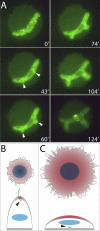Cells in tight spaces: the role of cell shape in cell function
- PMID: 20956377
- PMCID: PMC2958483
- DOI: 10.1083/jcb.201009048
Cells in tight spaces: the role of cell shape in cell function
Abstract
In this issue, Pitaval et al. (2010. J. Cell Biol. doi:10.1083/jcb.201004003) demonstrate that cell geometry can regulate the elaboration of a primary cilium. Their findings and approaches are part of a historical line of inquiry investigating the role of cell shape in intracellular organization and cellular function.
Figures


Comment on
-
Cell shape and contractility regulate ciliogenesis in cell cycle-arrested cells.J Cell Biol. 2010 Oct 18;191(2):303-12. doi: 10.1083/jcb.201004003. J Cell Biol. 2010. PMID: 20956379 Free PMC article.
References
-
- Driesch H. 1893. Entwicklungsmechanische Studien. Zeitschrift für Wissenschaftliche Zoologie. 55:1–62
Publication types
MeSH terms
Grants and funding
LinkOut - more resources
Full Text Sources
Other Literature Sources

